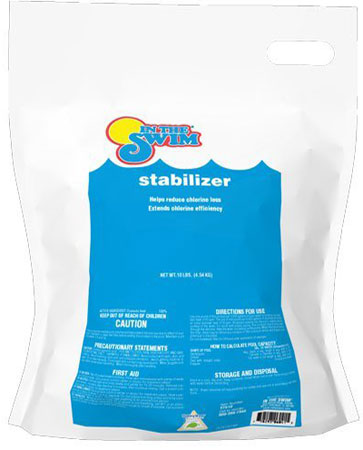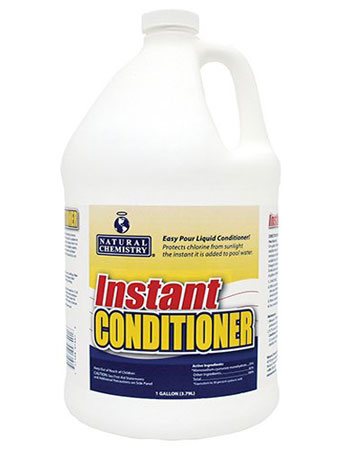Cyanuric acid used as a swimming pool chlorine stabilizer. The Chlorine sanitizes the pool water and keeps the water clean and safe for the swimmers. In presence of sun light and high temperatures it is very unstable; it breaks down into inactive components and losses its effectiveness. Therefore to maintain the chlorine level for water disinfection, we have to add more amount of chlorine. It increases the chemical cost. The pool Cyanuric acid reacts with the free chlorine and forms a compound to give it more stability in sunlight. Consequently, it reduces the loss of free chlorine in presence of UV light. In other words, it reduces the cost of pool water maintenance. If you neglect it then you will loss huge amount of chlorine.
Cyanuric acid is also known as CYA. The chemical formula of it is (CNOH)3. It is white and odorless solid. It has lower pH.
As the sunlight doesn’t enter the indoor pools, so you do not need stabilized the pool. In this case 5-10 ppm Cyanuric acid is enough. It will lessen the chloramines formation.
Without stabilizer a pool can loss about 80-90% of its free chlorine within a few hours in presence of UV rays.

In The Swim Pool Chlorine Stabilizer and Conditioner – 10 lb. Bag
Cyanuric acid test
It is recommended that you should regular test of your swimming pool chlorine stabilizer to keep the appropriate levels. The chemical test for pool cyanuric acid is very easy. You can determine it with the test strips. If the stabilizer level is too low then you have to add the required amount to bring the level up.
Pool stabilizer levels
The acceptable pool stabilizer levels are 30 – 80 ppm. To properly maintain the ideal level is about 35-50ppm. The ideal level may differ depends on region. For example, in northern areas the ideal range is 20-40 ppm. On the other hand, in some region the acceptable is up to 100ppm. Low or high cyanuric acid in pool is not recommended, both are harmful to pool.
High cyanuric acid in pool
Higher swimming pool chlorine stabilizer levels can slower the effectiveness of chlorine. Therefore it is not able to kill bacteria and micro-organisms, and prevent algae. Moreover, it also increases the cloudiness of pool water. In contrast there is no evidence that it is carcinogenic. If the pool stabilizer level cross the 100ppm, then your chlorine can turn into ineffective.

Natural Chemistry Liquid Swimming Pool Stabilizer and Conditioner – 1 Gallon
Lowering cyanuric acid in pool
There is no chemical available in the market to lower the stabilizer. You should regular monitoring it to maintain the acceptable level. You can follow the following method to lowering the swimming pool chlorine stabilizer.
Replace with fresh water: You can replace a portion of pool water with fresh water. However the replacing of water is very costly.
Used non-stabilized chlorine product: Different stabilized chlorine products are available in the market such as dichloro or trichloro products. These types of stabilized chlorine products may contain up to 5% or higher stabilizer. They could increases the level of Cyanuric acid. Hence, if the level is too high, you should use non-stabilized chlorine product when needed. You should know that regular backwashing helps to stay the pool stabilizer level lower.
Low cyanuric acid in pool
We know that low cyanuric acid in pool can’t able to stabilize the chlorine properly. Therefore, free chlorine can be released into air. As a result it cannot do sanitized pool water perfectly. If the cyanuric acid test shows that the level is low, then you have to need add the stabilizer. For example to raise about 20ppm for a 3000 gallons swimming pool, you have to add about 200 gm. Swimming pool chlorine stabilizer is dropped due to drain, backwash, splashout or winterization.
The formula is not correct for the amount of CYA to add for 20ppm. The numbers you used would lead to astronomical CYA concentration.
Thanks ‘Christiaan ‘ for your great information. I made a mistake. It would be 200gm instead of 200kg. I corrected it.
Pool chemicals are used to maintain a pH hostile to harmful organisms. A swimming pool can be a tempting location for bacteria and other potentially pathogenic organisms if the pH is not kept in balance, and people can get sick. Levels need to be adjusted as water splashes out and is replaced, and because chemicals like chlorine can interact with ultraviolet radiation. On sunny, hot days, chlorine can rapidly deteriorate, making the pool less safe and requiring people to add chemicals to bring the level back up to normal.
You might want to change “In this case 5-10% Cyanuric acid is enough. ” That equates to 50,000-100,000 ppm.
Thanks